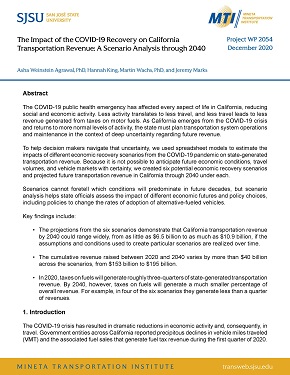- 408-924-7560
- mineta-institute@sjsu.edu
- Donate
The Impact of the COVID-19 Recovery on California Transportation Revenue: A Scenario Analysis through 2040
The COVID-19 public health emergency has affected every aspect of life in California, reducing social and economic activity. Less activity translates to less travel, and less travel leads to less revenue generated from taxes on motor fuels. As California emerges from the COVID-19 crisis and returns to more normal levels of activity, the state must plan transportation system operations and maintenance in the context of deep uncertainty regarding future revenue.
To help decision makers navigate that uncertainty, we used spreadsheet models to estimate the impacts of different economic recovery scenarios from the COVID-19 pandemic on state-generated transportation revenue. Because it is not possible to anticipate future economic conditions, travel volumes, and vehicle markets with certainty, we created six potential economic recovery scenarios and projected future transportation revenue in California through 2040 under each.
Scenarios cannot foretell which conditions will predominate in future decades, but scenario analysis helps state officials assess the impact of different economic futures and policy choices, including policies to change the rates of adoption of alternative-fueled vehicles.
Key findings include:
- The projections from the six scenarios demonstrate that California transportation revenue by 2040 could range widely, from as little as $6.5 billion to as much as $10.9 billion, if the assumptions and conditions used to create particular scenarios are realized over time.
- The cumulative revenue raised between 2020 and 2040 varies by more than $40 billion across the scenarios, from $153 billion to $195 billion.
- In 2020, taxes on fuels will generate roughly three-quarters of state-generated transportation revenue. By 2040, however, taxes on fuels will generate a much smaller percentage of overall revenue. For example, in four of the six scenarios they generate less than a quarter of revenues.
ASHA WEINSTEIN AGRAWAL, PhD
Dr. Agrawal is the Director of the MTI National Transportation Finance Center and also Professor of Urban and Regional Planning at San José State University. Her research and teaching interests in transportation policy and planning include transportation finance, bicycle and pedestrian planning, and travel survey methods.
HANNAH KING
Hannah King is currently a PhD student in transportation planning & policy at UCLA. Her research focuses on transportation finance, transportation equity, and travel behavior. Prior to coming to UCLA, she earned a Master’s in Urban and Regional Planning and a Master’s in Geographic Information Systems from Florida State University.
MARTIN WACHS, PhD
Dr. Wachs is Distinguished Professor Emeritus of Civil & Environmental Engineering and of City and Regional Planning at the University of California, Berkeley, where he directed the Institute of Transportation Studies. Wachs currently serves as a member of both the California High Speed Rail Peer Review Group and the Technical Advisory Committee for the California Road Charge Pilot Program.
JEREMY MARKS, MURP
Jeremy Marks is a Public Administration Analyst at UCLA’s Institute of Transportation Studies.
-
Contact Us
San José State University One Washington Square, San Jose, CA 95192 Phone: 408-924-7560 Email: mineta-institute@sjsu.edu






